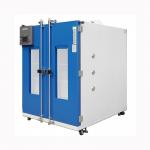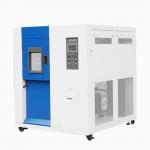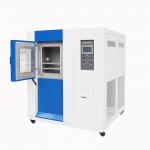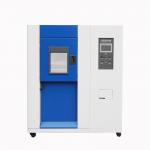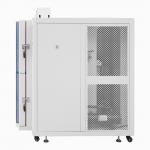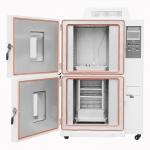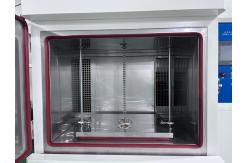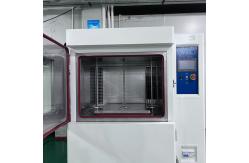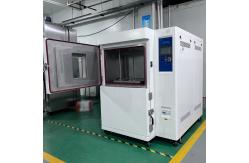In the realm of product testing and quality assurance, the ability
to subject materials and components to rapid and extreme
temperature changes is of utmost importance. The customized thermal
shock test chamber, with a temperature range spanning from -55℃ to
150℃, emerges as a powerful tool that enables manufacturers and
researchers to evaluate the durability and performance of a wide
array of products under the harshest thermal conditions. This highly specialized test chamber is designed to replicate the
rapid temperature fluctuations that products may encounter during
their operational lifetimes or in extreme environmental scenarios.
It caters to a diverse range of industries, including aerospace,
automotive, electronics, and military. The primary objective is to
identify potential weaknesses, such as material fatigue, cracking,
or delamination, that can occur due to sudden and severe
temperature differentials. By subjecting samples to thermal shock
cycles, manufacturers can optimize product designs, enhance
reliability, and ensure compliance with stringent industry
standards. - Robust and Insulated Chamber Structure
- The thermal shock test chamber is constructed with a heavy-duty
steel frame that provides exceptional rigidity and stability. The
frame is coated with a corrosion-resistant finish to prolong its
service life. The chamber is divided into two distinct
compartments, a hot zone and a cold zone, each with its own
independent temperature control system. The walls of the chambers
are made of high-quality insulation materials, which minimize heat
transfer between the zones and maintain precise temperature levels.
The insulation is carefully engineered to withstand the rigors of
continuous thermal cycling and prevent any external factors from
interfering with the internal test environment. The chamber is also
equipped with a hermetic door seal, ensuring a leak-free enclosure
and consistent test conditions.
- Precision Temperature Control System
- Each zone of the chamber features a highly accurate temperature
control system. The hot zone can maintain temperatures up to 150℃
with an accuracy of ±0.5℃, while the cold zone can reach as low as
-55℃ with the same level of precision. The systems utilize advanced
heating elements and refrigeration units, along with PID
controllers, to achieve and maintain the desired temperature
settings. Temperature sensors are strategically placed within the
chambers to provide real-time feedback, enabling the control
systems to make rapid and precise adjustments. The ability to
transition between extreme hot and cold temperatures quickly is a
key feature, with a typical temperature change rate of up to 20℃
per minute.
- Versatile Sample Handling Mechanism
- The chamber is equipped with a sophisticated sample handling
mechanism that allows for easy and efficient transfer of test
samples between the hot and cold zones. This can be achieved
through a pneumatic or mechanical transfer system, which ensures
rapid movement of samples without significant temperature
equilibration during the transfer process. The system is designed
to accommodate a variety of sample sizes and shapes, and can be
customized to meet specific testing requirements. Additionally, the
chamber can be fitted with sample holders and racks made of
non-corrosive and heat-resistant materials to ensure proper sample
positioning and support.
- Intuitive Control and Data Acquisition Interface
- The equipment is equipped with an intuitive control panel and a
comprehensive data acquisition system. The control panel allows
operators to easily set and adjust the temperature parameters, test
durations, and cycle repetitions. It provides real-time display of
the current temperature in each zone, as well as any alarms or
warnings. The data acquisition system records all relevant test
data, including temperature profiles, temperature change rates, and
any changes in the physical properties of the test samples. The
data can be stored in a built-in memory or exported to external
storage devices for further analysis. The system also has the
ability to generate detailed test reports in various formats, such
as PDF or Excel.
- Safety and Protection Mechanisms
- To ensure the safety of operators and the integrity of the testing
process, the chamber is equipped with a range of safety features.
It has emergency stop buttons strategically located for immediate
shutdown in case of any abnormal situation. The chamber is also
protected against over-temperature and over-current conditions,
with built-in safety circuits that automatically cut off power if
necessary. Additionally, the chamber is designed to prevent any
refrigerant leaks, and it has a ventilation system to ensure the
removal of any potentially harmful gases. The door of the chamber
is interlocked, preventing it from being opened during a test cycle
to avoid sudden temperature changes and potential hazards.
- Maximum Temperature Swing
- The chamber can achieve a maximum temperature swing of 205℃ (from
-55℃ to 150℃). This wide temperature range allows for the
simulation of the most extreme thermal conditions that products may
face. For example, in aerospace applications, components may
experience rapid temperature changes during flight, such as when
transitioning from the cold upper atmosphere to the hot engine
compartment. Testing within this temperature swing helps to
identify potential issues related to thermal expansion and
contraction, ensuring the reliability of critical aerospace
systems.
- Temperature Change Rate
- As mentioned, the temperature can change at a rate of up to 20℃ per
minute. This rapid rate of change is essential for accurately
simulating real-world thermal shock events. In the electronics
industry, for instance, components may be exposed to sudden
temperature changes when a device is powered on or off, or when it
is moved from a cold storage environment to a warm operating
environment. By testing at this rate, manufacturers can evaluate
the ability of electronic components, such as circuit boards and
semiconductors, to withstand thermal stress without failure.
- Testing Volume and Payload Capacity
- The chamber offers a customizable testing volume, with options
ranging from 1 m³ to 20 m³. The payload capacity can be adjusted
according to the size and weight of the test samples, with a
maximum capacity of up to 1000 kg. This flexibility allows for the
testing of a wide variety of products, from small electronic
modules to large industrial components. For example, in the
automotive industry, it can be used to test the durability of
engine parts, transmission components, or even entire vehicle
subsystems.
- Temperature Uniformity
- The chamber ensures excellent temperature uniformity within each
zone. The temperature variation within the hot zone and the cold
zone is typically within ±1℃. This level of uniformity is crucial
for obtaining accurate and reliable test results, as it ensures
that all parts of the test sample are exposed to the same
temperature conditions. In applications where precise temperature
control is essential, such as in the testing of sensitive
electronic components or high-precision optical devices, this
feature is of utmost importance.
- Dwell Time Accuracy
- The chamber can maintain the specified dwell times at different
temperature levels with an accuracy of ±1 minute. Dwell time is an
important parameter in thermal shock testing, as it determines the
length of time the product is exposed to a particular temperature.
Accurate control of dwell time ensures that the test is conducted
in accordance with the defined test plan and provides consistent
results. For example, in testing the reliability of a new material,
the dwell time at extreme temperatures can help to assess its
long-term stability and resistance to thermal degradation.
|
